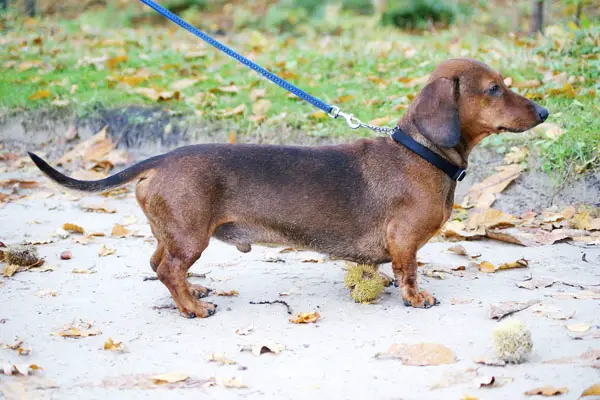Dachshunds are generally known for their long bodies and little legs. They are also known as Wiener Dogs or Sausage Dogs because of this look. However, even with their small size, the Dachshund has a big personality.
Dachshunds are great additions to any family. They carry their small body confidently, which can bring a smile or laughter to anyone who sees them. They are smart, vigilant, and are certainly game for anything.
With their unique appearance and adorable personality, they are also favorite subjects by many artists, famous or not, in paintings.

Dachshund Statistics
| Dog Breed Group | Hound |
| Breed Size | Small |
| Height | 8-9 inches (standard); 5-16 inches (miniature) |
| Weight | 16-32 pounds (standard); 11 pounds & under (miniature) |
| Lifespan | 12-16 years |
Dachshund Ratings
Related article: Best Dog Food For Dachshunds
| Energy level | |
| Exercise needs | |
| Requires attention | |
| Playfulness | |
| Trainability | |
| Shedding | |
| Grooming | |
| Friendly with family | |
| Friendly with kids | |
| Friendly with strangers | |
| Friendly with other dogs | |
| Prey Drive |
History Of The Dachshund
Historical evidence suggests that Dachshund-like dogs have existed since the 15th century. There were also documents in the 16th century that mentioned badger creepers and dachsel, which might be pertaining to the Dachshunds. However, it was also believed that it was not until the 17th and 18th centuries that the Germans created the modern Dachshunds.
During that time, German foresters have wanted to develop a badger dog that is fearless, elongated, and brave to fight badgers to death – the goal is to kill. Dachshunds, also known as Teckel at that time, was the closest breed they had developed that could do this.
The Dachshunds’ long and low body was made so he can easily dig his way to the badger’s den. Their front paws are paddle-shaped to assist in any extreme digging they need to do. Their ears, which lie flat, keep the dirt away from his burrowing.
Continuous development of the breed created two sizes: standard and miniature. These various sizes allowed them to hunt other prey, such as rabbits and foxes. They are even used to trail wild boars.
Their cleverness, bravery, and persistence allow them to fight head to head with any of its prey. And their loud bark enables their companion hunters to know where their location underground is. This breed is also the only breed identified that can hunt above and below ground.
By the 1800s, the breed started becoming popular as pets. They were most especially loved in the Royal Courts of Europe, including Queen Victoria’s whom her love for the breed was never a secret.
By 1885, the breed reached America and finally was registered under the American Kennel Club.
Temperament Of The Dachshund
Dachshunds are best described as smart, brave, and full of life. They love games, and they certainly like to be in on everything. When it comes to their family, they are very loyal and attached. They’re also good with children.
However, the same can’t be said when it comes to strangers and other dogs. They are overly protective of family and can be a bit aggressive with people and animals they don’t know. They make excellent watchdogs, especially with their loud bark.
As Dachshunds are very smart, they need exercises where they’ll be able to use their mind. They need to be engaged continuously, and they are best paired with people who are not often outside so they can be attended to well.
They can get needy; leaving them alone for a long time will cause distress and separation anxiety.
Training them might require patience and persistence. They are independent, and they can sometimes be stubborn. Sometimes, they will talk back and clash with their owners. You can make use of their playful nature by letting them play fetch and other games he would enjoy.
If you have larger dogs at home, Dachshunds may also find it hard to be friendly with them. However, if they grew up together, then this might not be a problem. Jealousy is also very prone to Dachshunds, and they will keep toys if they want to.
The key here would be early socialization. They need to be socialized with strangers and other pets. Also, keep them on a leash when walking them as they can get a little adventurous.

Dachshund Care Requirements
- Nutrition: Dachshunds must maintain their ideal weight, which is why they need to have a well-balanced diet. This dog breed loves to eat, so it’s really up to the owner to watch what he eats and make sure it’s controlled. The ideal daily calorie intake for Dachshunds would likely depend on their size. Dachshunds puppies, in general, should be fed 3-4 times a day of 1 oz of food per pound of body weight. Adult Dachshunds might only be needed to eat twice a day and about 1 to 1 ¾ cups depending on their weight. The quality should be high as well. Protein is essential to keep a Dachshund’s energy. You can opt for chicken, fish, beef, or lamb as the main ingredient. Avoid foods made with fillers as they don’t contain any nutritional value. You can also add treats as part of your Dachshund’s diet and only give it to them as a reward or part of the training. Also, calculate the calories in the treats too.
- Grooming: Dachshunds are generally clean and occasionally sheds. However, grooming usually depends on the type of coat they wear. Of the three coat types, shorthaired or smooth-haired dachshunds require the least grooming. Some even refer to it as a “wash and wear” kind of coat. Sometimes, you would only need to wipe it up with a towel. Long-haired Dachshunds require regular brushing, especially if their coat is thick. This is to ensure that no tangles will form. Mats can develop right behind the ears, so it’s an area that needs to be paid attention to. Wire-haired Dachshunds need frequent brushing as well, especially after spring and fall. Their coat can be plucked or hand-stripped several times in a year to make sure it always looks its best. Make sure also to check ears and nails to ensure that your Dachshunds are always at their best-groomed selves.
- Exercise: Dachshunds require a lot of activities other than running. They are smart dogs, and they were original hunters, staying active is something that they need. They also need this so they can stay fit. Walking Dachshunds at least twice a day should suffice. But to exercise their mind, give them other activities as well, such as playing fetch. Keep things fun, and make sure that you come with treats too.
- Health: Dachshunds, just like other dog breeds, are also prone to health problems if not taken care of properly. Most came from genetics, but some are also common health problems of dogs. Intervertebral Disk Disease is one common disease that affects Dachshunds the most because of their unique skeletal design. This is why it’s essential to keep them away from activities that can strain their spine. Acanthosis Nigricans is another disease that is unique to Dachshunds, though the origin is not entirely clear. Hypothyroidism, eye problems, obesity, skin problems, and back injuries are also some problems that a Dachshund owner should watch out for.
- Lifespan: The life expectancy of Dachshunds is 12-16 years.

Famous Dachshunds
- Lump: Picasso’s dog who showed up in several of his paintings
- Archie and Amos: Dachshund dogs of Andy Warhol, another painter
- Stanley and Boodgie: Subjects of David Hockney’s (a celebrated architect and painter) “Dog’s Days”
- Waldi: The first-ever mascot of the Olympics in Munich in the year 1972
- Helen: William Randolph Hearst Dachshund
- Wadl, Hexl, and Senta: Dachshunds of Kaiser Wilhelm II, the last emperor of Germany; Senta accompanied Kaiser during WWI; Wadl and Hexl are famous for gobbling up one of Archduke Franz Ferdinand of Austria’s golden pheasants
- Blackie: John Wayne’s Dachshund who saved his wife and baby from a fire
- Obie: Became known as the obese Dachshund that reached a weight of 77 pounds (don’t worry though, he’s now back to the normal weight of 28 pounds)
- Winnie: The first British dog successfully cloned
Fun Facts About Dachshunds
- Dachshunds are originally bred to hunt badgers; the name “Dachshund” is a German term for “badger dog.”
- Dachshunds have two sizes: standard and miniature.
- They have three different kinds of coats: smooth, wire-haired, and long-haired.
- The first official mascot of the Olympics is a Dachshund.
- Two Dachshunds have held the record of the world’s oldest dog in the Guinness Book of World Records; one at 21 years old and the other at 20 years old
- Famous artists such as Picasso, Warhol, and Hockney love Dachshunds.
- Dachshunds were Queen Victoria’s favorite dog breed.
- They are the smallest hunting breed.
- Dachshunds rank 12 as the most popular dog breed.
Check Out Other Hound Dog Breeds:
Afghan Hound, American English Coonhounds, American Foxhound, Basenjis, Basset Hound, Beagle, Black and Tan Coonhound, Bloodhound, Bluetick Coonhound, Borzois, Cirnechi dell’Etna, English Foxhound, Grand Basset Griffon Vendeens, Greyhound, Harrier, Ibizan Hound, Icelandic Sheepdogs, Irish Wolfhound, Norwegian Elkhound, Otterhound, Petit Basset Griffon Vendéen, Pharaoh Hounds, Plotts, Portuguese Podengo, Redbone Coonhound, Rhodesian Ridgeback, Salukis, Scottish Deerhounds, Sloughis, Treeing Walker Coonhound, Whippet
